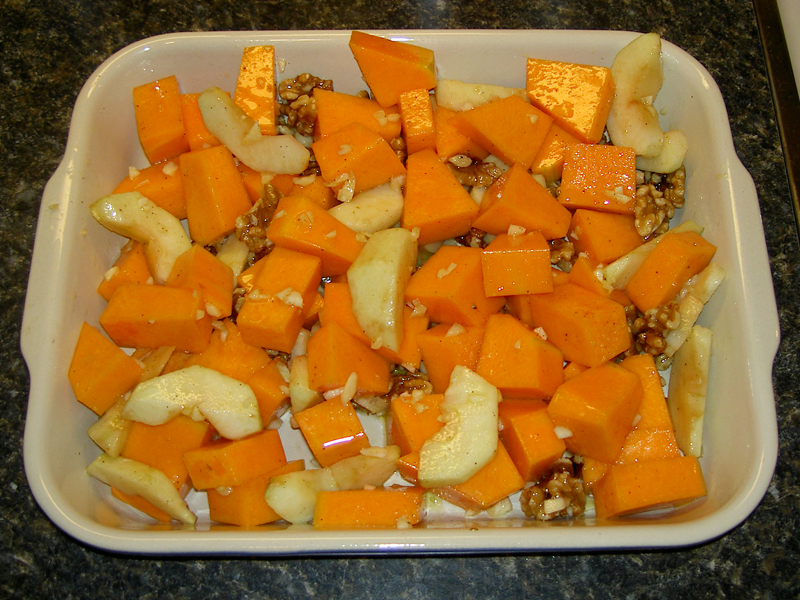Over the past month we’ve been shifting to a high-fiber low-saturated-fat way of eating in our house. Because of my eating choices — no mammal flesh, no dairy — we largely ate this way already. Largely hasn’t been good enough, though: my partner’s cholesterol is unacceptably high. Not just high overall, but inverted on each individual measure (high triglycerides, low HDLs, high LDLs). So, we’re (as my students used to say) taking it to the next level.
The next level, such as it is, involves no butter, egg substitutes, and whole wheat flour (we already bought whole wheat bread and high fiber cereal, just because those generally contained the smallest amounts of sugar). It also involves salads every day, which isn’t difficult with the food from our farm share and the community garden streaming in, and fish oil supplements. In addition to boosting fiber and shifting to exclusively using non-animal fats, I’ve also been trying to include things like rhubarb and walnuts in our meals, both of which are purported to specifically contribute to lower cholesterol.
In the course of trying to find something that’s tasty and moderately sweet that meets these criteria, I have been baking variations of the muffin recipe from Moosewood Restaurant Cooks At Home (one of my favorite cookbooks for food that’s delicious and easy to make). While the recipe doesn’t call for whole wheat flour, I find that I actually like the muffins better when made that way. And, most of the variations call for walnuts!
Muffin Madness
wet ingredients
1/2 cup egg substitute (equal to 2 large eggs)
1/2 cup vegetable oil
3/4-1 cup brown sugar
1/2 tsp vanilla extract
dry ingredients
2 cups whole wheat flour
1 tsp baking powder
1/2 tsp salt
additional ingredients
blueberry lemon
1 1/2 cup blueberries (add to wet ingredients)
1 tbsp freshly grated lemon peel (add to wet ingredients)
banana nut
1 1/2 cup mashed bananas (add to wet ingredients)
1 cup chopped walnuts (add last)
optional: handful of blueberries
zucchini
2 cups grated zucchini (add to wet ingredients)
1 tsp cinnamon (add to dry ingredients)
1/2 tsp cardamom (add to dry ingredients)
1/2 cup raisins (add at end)
3/4 cup chopped walnuts (add at end)
apple
2 cups grated apples (add to wet ingredients)
1 tsp grated lemon peel (add to wet ingredients)
1/2 tsp cinnamon (add to dry ingredients)
1/2 cup chopped walnuts (add at the end)
rhubarb
1 1/2 cup diced rhubarb (add to wet ingredients)
1/2 to 1 cup chopped walnuts (add at end)
1 1/2 tsp cinnamon (add to dry ingredients)
Preheat oven to 350 degrees. In a large bowl, mix together the wet ingredients, then stir in the additional ingredients and mix well. In a separate bowl, sift together the dry ingredients. Combine wet and dry, being careful not to overmix the batter. Spoon the batter into oiled standard muffin tins, and bake for 20-25 minutes, until puffed and golden (test with toothpick; they are done in my oven, which tends to need more time, after 23 minutes). If you are using mini-muffin trays, only bake for 10-15 minutes. Each plain muffin is listed as having 220 calories; I don’t know how much the adjustments to the recipe might change that.
Finally, the recipe emphasizes that the basic ingredients do not make a plain muffin: you must choose a variation to get the delicious end product!
I’ve been making a batch of these at least once, usually twice a week. We eat them warm for breakfast or as dessert in the evening, and then with our lunches through the week. I like each of the variations in their own way. The banana ones are sweeter, and I tend to use less sugar (more like 1/2 cup, especially when I’m putting in blueberries). The zucchini ones require more sugar because of the strong spices; they were more like a savory bread when I used only a minimal amount of sugar. I’ve made the rhubarb ones most often (and tucked away chopped rhubarb in the freezer, for when the season’s over), and the tartness of the rhubarb is nice. Maybe you have to have grown up in the Midwest to appreciate rhubarb? At any rate, we like it.
My serving recommendation: warm, with a big cup of strong coffee.

